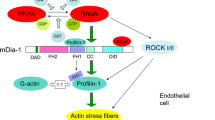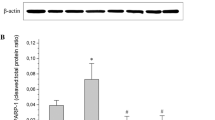Abstract
Aims
Nucleoside diphosphate kinase B (NDPKB) is capable of maintaining the cellular nucleotide triphosphate pools. It might therefore supply UTP for the formation of UDP-GlcNAc from glucose. As NDPKB contributes to vascular dysfunction, we speculate that NDPKB might play a role in microangiopathies, such as diabetic retinopathy (DR). Therefore, we investigated the impact of NDPKB on retinal vascular damage using NDPKB−/− mice during development of DR and its possible mechanisms.
Methods
Pericyte loss and acellular capillary (AC) formation were assessed in streptozotocin-induced diabetic NDPKB−/− and wild-type (WT) mice. Expression of angiopoietin-2 (Ang2) and protein N-acetylglucosamine modification (GlcNAcylation) were assessed by western blot and/or immunofluorescence in the diabetic retinas as well as in endothelial cells depleted of NDPKB by siRNA and stimulated with high glucose.
Results
Similar to diabetic WT retinas, non-diabetic NDPKB−/− retinas showed a significant decrease in pericyte coverage in comparison with non-diabetic WT retinas. Hyperglycemia further aggravates pericyte loss in diabetic NDPKB−/− retinas. AC formation was detected in the diabetic NDPKB−/− retinas. Similar to hyperglycemia, NDPKB deficiency induced Ang2 expression and protein GlcNAcylation that were not further altered in the diabetic retinas. In cultured endothelial cells, stimulation with high glucose and NDPKB depletion comparably increased Ang2 expression and protein GlcNAcylation.
Conclusions
Our data identify NDPKB as a protective factor in the retina, which controls Ang2 expression and the hexosamine pathway. NDPKB-deficient mice are a suitable model for studying mechanisms underlying diabetic retinal vascular damage.




Similar content being viewed by others
References
Lascu I, Gonin P (2000) The catalytic mechanism of nucleoside diphosphate kinases. J Bioenerg Biomembr 32(3):237–246
Gilles AM, Presecan E, Vonica A, Lascu I (1991) Nucleoside diphosphate kinase from human erythrocytes. Structural characterization of the two polypeptide chains responsible for heterogeneity of the hexameric enzyme. J Biol Chem 266(14):8784–8789
Janin J, Dumas C, Morera S, Xu Y, Meyer P, Chiadmi M, Cherfils J (2000) Three-dimensional structure of nucleoside diphosphate kinase. J Bioenerg Biomembr 32(3):215–225
Cipollini G, Berti A, Fiore L, Rainaldi G, Basolo F, Merlo G, Bevilacqua G, Caligo MA (1997) Down-regulation of the nm23.h1 gene inhibits cell proliferation. Int J Cancer 73(2):297–302
Fournier HN, Albiges-Rizo C, Block MR (2003) New insights into Nm23 control of cell adhesion and migration. J Bioenerg Biomembr 35(1):81–87
Gervasi F, D’Agnano I, Vossio S, Zupi G, Sacchi A, Lombardi D (1996) nm23 influences proliferation and differentiation of PC12 cells in response to nerve growth factor. Cell Growth Differ 7(12):1689–1695
Kang Y, Lee DC, Han J, Yoon S, Won M, Yeom JH, Seong MJ, Ko JJ, Lee KA, Lee K, Bae J (2007) NM23-H2 involves in negative regulation of Diva and Bcl2L10 in apoptosis signaling. Biochem Biophys Res Commun 359(1):76–82
Krishnan KS, Rikhy R, Rao S, Shivalkar M, Mosko M, Narayanan R, Etter P, Estes PS, Ramaswami M (2001) Nucleoside diphosphate kinase, a source of GTP, is required for dynamin-dependent synaptic vesicle recycling. Neuron 30(1):197–210
Palacios F, Schweitzer JK, Boshans RL, D’Souza-Schorey C (2002) ARF6-GTP recruits Nm23-H1 to facilitate dynamin-mediated endocytosis during adherens junctions disassembly. Nat Cell Biol 4(12):929–936
Brownlee M (2005) The pathobiology of diabetic complications: a unifying mechanism. Diabetes 54(6):1615–1625
Hart GW, Slawson C, Ramirez-Correa G, Lagerlof O (2011) Cross talk between O-GlcNAcylation and phosphorylation: roles in signaling, transcription, and chronic disease. Annu Rev Biochem 80:825–858
Feng Y, Gross S, Wolf NM, Butenschon VM, Qiu Y, Devraj K, Liebner S, Kroll J, Skolnik EY, Hammes HP, Wieland T (2014) Nucleoside diphosphate kinase B regulates angiogenesis through modulation of vascular endothelial growth factor receptor type 2 and endothelial adherens junction proteins. Arterioscler Thromb Vasc Biol 34(10):2292–2300
Hammes HP, Feng Y, Pfister F, Brownlee M (2011) Diabetic retinopathy: targeting vasoregression. Diabetes 60(1):9–16
Feng Y, Pfister F, Schreiter K, Wang Y, Stock O, Vom Hagen F, Wolburg H, Hoffmann S, Deutsch U, Hammes HP (2008) Angiopoietin-2 deficiency decelerates age-dependent vascular changes in the mouse retina. Cell Physiol Biochem 21(1–3):129–136
Feng Y, Vom Hagen F, Wang Y, Beck S, Schreiter K, Pfister F, Hoffmann S, Wagner P, Seeliger M, Molema G, Deutsch U, Hammes HP (2009) The absence of angiopoietin-2 leads to abnormal vascular maturation and persistent proliferative retinopathy. Thromb Haemost 102(1):120–130
Hammes HP, Lin J, Wagner P, Feng Y, Vom Hagen F, Krzizok T, Renner O, Breier G, Brownlee M, Deutsch U (2004) Angiopoietin-2 causes pericyte dropout in the normal retina: evidence for involvement in diabetic retinopathy. Diabetes 53(4):1104–1110
Pfister F, Feng Y, Vom Hagen F, Hoffmann S, Molema G, Hillebrands JL, Shani M, Deutsch U, Hammes HP (2008) Pericyte migration: a novel mechanism of pericyte loss in experimental diabetic retinopathy. Diabetes 57(9):2495–2502
Yao D, Taguchi T, Matsumura T, Pestell R, Edelstein D, Giardino I, Suske G, Rabbani N, Thornalley PJ, Sarthy VP, Hammes HP, Brownlee M (2007) High glucose increases angiopoietin-2 transcription in microvascular endothelial cells through methylglyoxal modification of mSin3A. J Biol Chem 282(42):31038–31045
Di L, Srivastava S, Zhdanova O, Sun Y, Li Z, Skolnik EY (2010) Nucleoside diphosphate kinase B knock-out mice have impaired activation of the K+ channel KCa3.1, resulting in defective T cell activation. J Biol Chem 285(50):38765–38771
Hammes HP, Lin J, Renner O, Shani M, Lundqvist A, Betsholtz C, Brownlee M, Deutsch U (2002) Pericytes and the pathogenesis of diabetic retinopathy. Diabetes 51(10):3107–3112
Kroll J, Epting D, Kern K, Dietz CT, Feng Y, Hammes HP, Wieland T, Augustin HG (2009) Inhibition of Rho-dependent kinases ROCK I/II activates VEGF-driven retinal neovascularization and sprouting angiogenesis. Am J Physiol Heart Circ Physiol 296(3):H893–H899
Feng Y, Vom Hagen F, Pfister F, Djokic S, Hoffmann S, Back W, Wagner P, Lin J, Deutsch U, Hammes HP (2007) Impaired pericyte recruitment and abnormal retinal angiogenesis as a result of angiopoietin-2 overexpression. Thromb Haemost 97(1):99–108
Lacombe ML, Milon L, Munier A, Mehus JG, Lambeth DO (2000) The human Nm23/nucleoside diphosphate kinases. J Bioenerg Biomembr 32(3):247–258
Hsu T, Steeg PS, Zollo M, Wieland T (2015) Progress on Nme (NDP kinase/Nm23/Awd) gene family-related functions derived from animal model systems: studies on development, cardiovascular disease, and cancer metastasis exemplified. Naunyn Schmiedebergs Arch Pharmacol 388(2):109–117
Attwood PV, Wieland T (2015) Nucleoside diphosphate kinase as protein histidine kinase. Naunyn Schmiedebergs Arch Pharmacol 388(2):153–160
Berberich SJ, Postel EH (1995) PuF/NM23-H2/NDPK-B transactivates a human c-myc promoter-CAT gene via a functional nuclease hypersensitive element. Oncogene 10(12):2343–2347
Hippe HJ, Wolf NM, Abu-Taha HI, Lutz S, Le Lay S, Just S, Rottbauer W, Katus HA, Wieland T (2011) Nucleoside diphosphate kinase B is required for the formation of heterotrimeric G protein containing caveolae. Naunyn Schmiedebergs Arch Pharmacol 384(4–5):461–472
Hippe HJ, Wolf NM, Abu-Taha I, Mehringer R, Just S, Lutz S, Niroomand F, Postel EH, Katus HA, Rottbauer W, Wieland T (2009) The interaction of nucleoside diphosphate kinase B with Gbetagamma dimers controls heterotrimeric G protein function. Proc Natl Acad Sci USA 106(38):16269–16274
Rayner K, Chen YX, Hibbert B, White D, Miller H, Postel EH, O’Brien ER (2007) NM23-H2, an estrogen receptor beta-associated protein, shows diminished expression with progression of atherosclerosis. Am J Physiol Regul Integr Comp Physiol 292(2):R743–R750
Rayner K, Chen YX, Hibbert B, White D, Miller H, Postel EH, O’Brien ER (2008) Discovery of NM23-H2 as an estrogen receptor beta-associated protein: role in estrogen-induced gene transcription and cell migration. J Steroid Biochem Mol Biol 108(1–2):72–81
Fournier HN, Dupe-Manet S, Bouvard D, Lacombe ML, Marie C, Block MR, Albiges-Rizo C (2002) Integrin cytoplasmic domain-associated protein 1alpha (ICAP-1alpha) interacts directly with the metastasis suppressor nm23-H2, and both proteins are targeted to newly formed cell adhesion sites upon integrin engagement. J Biol Chem 277(23):20895–20902
Zippo A, De Robertis A, Bardelli M, Galvagni F, Oliviero S (2004) Identification of Flk-1 target genes in vasculogenesis: Pim-1 is required for endothelial and mural cell differentiation in vitro. Blood 103(12):4536–4544
Buxton IL, Yokdang N (2011) Extracellular NM23 signaling in breast cancer: incommodus verum. Cancers (Basel) 3(3):2844–2857
Yokdang N, Tellez JD, Tian H, Norvell J, Barsky SH, Valencik M, Buxton IL (2011) A role for nucleotides in support of breast cancer angiogenesis: heterologous receptor signalling. Br J Cancer 104(10):1628–1640
Pfister F, Wang Y, Schreiter K, Vom Hagen F, Altvater K, Hoffmann S, Deutsch U, Hammes HP, Feng Y (2010) Retinal overexpression of angiopoietin-2 mimics diabetic retinopathy and enhances vascular damages in hyperglycemia. Acta Diabetol 47(1):59–64
Jones SE, Jomary C, Grist J, Stewart HJ, Neal MJ (2000) Identification by array screening of altered nm23-M2/PuF mRNA expression in mouse retinal degeneration. Mol Cell Biol Res Commun MCBRC 4(1):20–25
Postel EH, Berberich SJ, Rooney JW, Kaetzel DM (2000) Human NM23/nucleoside diphosphate kinase regulates gene expression through DNA binding to nuclease-hypersensitive transcriptional elements. J Bioenerg Biomembr 32(3):277–284
Steeg PS, Zollo M, Wieland T (2011) A critical evaluation of biochemical activities reported for the nucleoside diphosphate kinase/Nm23/Awd family proteins: opportunities and missteps in understanding their biological functions. Naunyn Schmiedebergs Arch Pharmacol 384(4–5):331–339
Potente M, Urbich C, Sasaki K, Hofmann WK, Heeschen C, Aicher A, Kollipara R, DePinho RA, Zeiher AM, Dimmeler S (2005) Involvement of Foxo transcription factors in angiogenesis and postnatal neovascularization. J Clin Invest 115(9):2382–2392
Wieland T (2007) Interaction of nucleoside diphosphate kinase B with heterotrimeric G protein betagamma dimers: consequences on G protein activation and stability. Naunyn Schmiedebergs Arch Pharmacol 374(5–6):373–383
Wieland T, Nurnberg B, Ulibarri I, Kaldenberg-Stasch S, Schultz G, Jakobs KH (1993) Guanine nucleotide-specific phosphate transfer by guanine nucleotide-binding regulatory protein beta-subunits. Characterization of the phosphorylated amino acid. J Biol Chem 268(24):18111–18118
Wang HZ, Wu KY, Lin CP, Fong JC, Hong SJ (1997) Alteration of glucose uptake in cultured human corneal endothelial cells grown in high glucose media via cAMP-dependent pathway. Kaohsiung J Med Sci 13(9):566–571
Hart GW, Akimoto Y (2009) The O-GlcNAc modification. In: Varki A, Cummings RD, Esko JD et al (eds) Essentials of glycobiology, 2nd edn. Cold Spring Harbor Laboratory Press, New York
Kowluru A, Kowluru RA, Yamazaki A (1992) Functional alterations of G-proteins in diabetic rat retina: a possible explanation for the early visual abnormalities in diabetes mellitus. Diabetologia 35(7):624–631
Klaassen I, Hughes JM, Vogels IM, Schalkwijk CG, Van Noorden CJ, Schlingemann RO (2009) Altered expression of genes related to blood-retina barrier disruption in streptozotocin-induced diabetes. Exp Eye Res 89(1):4–15
Kern TS, Du Y, Miller CM, Hatala DA, Levin LA (2010) Overexpression of Bcl-2 in vascular endothelium inhibits the microvascular lesions of diabetic retinopathy. Am J Pathol 176(5):2550–2558
Acknowledgments
The authors thank Doris Baltus, Heike Rauscher and Kristina Stephan-Schnatz for excellent technical support. This study was supported by grants from the European Foundation for the Study of Diabetes (TW, YF) and the Deutsche Forschungsgemeinschaft (SFB TR23, TP B6 (TW) and A9 (SWS), and GRK 1874 SP2 (TW, YF)).
Conflict of interest
The authors declare that they have no conflict of interest.
Human and animal rights disclosure
Regarding HUVEC isolation, all procedures followed were in accordance with the ethical standards of the responsible committee on human experimentation (institutional and national) and with the Helsinki Declaration of 1975, as revised in 2008 (5). Regarding animal studies, all applicable international, national, and/or institutional guidelines for the care and use of animals were followed.
Informed consent disclosure
Informed consent was obtained from all patients for being included in the study.
Author information
Authors and Affiliations
Corresponding author
Additional information
Managed by Massimo Porta.
Yi Qiu and Di Zhao have contributed equally to this article.
Electronic supplementary material
Below is the link to the electronic supplementary material.

592_2015_752_MOESM1_ESM.jpg
Supplemental Fig. 1: localization of Ang2 in Weibel-Palade bodies in endothelial cells. Weibel-Palade-bodies were visualized by staining with von Willebrand factor (vWF) (JPEG 103 kb)
Rights and permissions
About this article
Cite this article
Qiu, Y., Zhao, D., Butenschön, VM. et al. Nucleoside diphosphate kinase B deficiency causes a diabetes-like vascular pathology via up-regulation of endothelial angiopoietin-2 in the retina. Acta Diabetol 53, 81–89 (2016). https://doi.org/10.1007/s00592-015-0752-x
Received:
Accepted:
Published:
Issue Date:
DOI: https://doi.org/10.1007/s00592-015-0752-x




